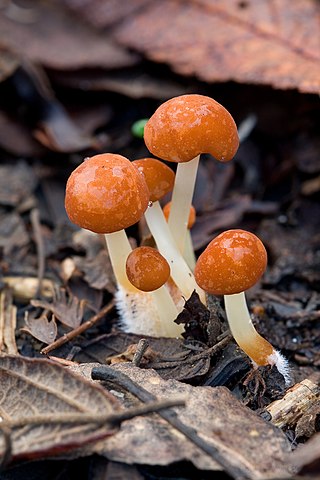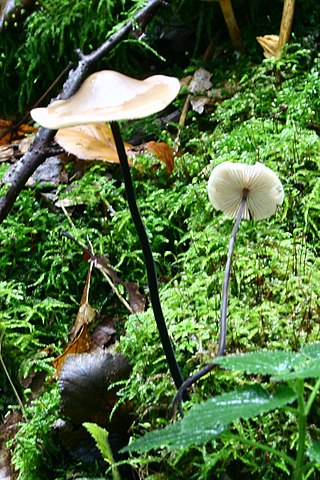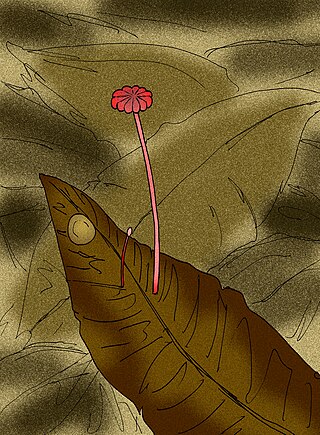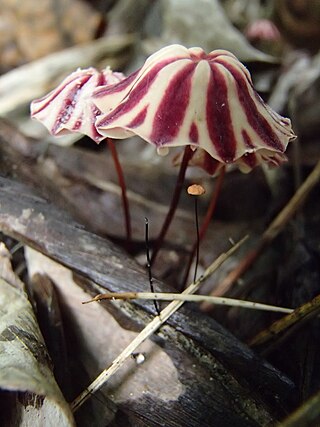
Marasmius is a genus of mushroom-forming fungi in the family Marasmiaceae. It contains about 500 species of agarics, of which a few, such as Marasmius oreades, are edible. However, most members of this genus are small, unimpressive brown mushrooms. Their humble appearance contributes to their not being readily distinguishable to non-specialists, and they are therefore seldom collected by mushroom hunters. Several of the species are known to grow in the characteristic fairy ring pattern.

The Marasmiaceae are a family of fungi in the order Agaricales. Basidiocarps are most frequently agarics, but occasionally cyphelloid. According to a 2008 estimate, the family contained 54 genera and 1590 species, but molecular research, based on cladistic analysis of DNA sequences, has led to a more restricted family concept, so that the Marasmiaceae included just 13 genera, and some 1205 species. It was reduced further down in 2020, to 10 genera and about 700 species.

Mycetinis alliaceus, commonly known as the garlic parachute, is one of the larger mushrooms formerly in the genus Marasmius, having a beige cap of up to 4 cm and a long tough slender stipe. It emanates a strong smell of garlic, and this is the significance of the Latin species name, alliaceus. It is distributed throughout Europe, being fairly common in some areas and quite rare in others.

Marasmius rotula is a common species of agaric fungus in the family Marasmiaceae. Widespread in the Northern Hemisphere, it is commonly known variously as the pinwheel mushroom, the pinwheel marasmius, the little wheel, the collared parachute, or the horse hair fungus. The type species of the genus Marasmius, M. rotula was first described scientifically in 1772 by mycologist Giovanni Antonio Scopoli and assigned its current name in 1838 by Elias Fries.

Archaeomarasmius is an extinct genus of gilled fungus in the Agaricales family Tricholomataceae, containing the single species Archaeomarasmius leggetti. It is known from two fruit bodies recovered from amber, one consisting of a complete cap with a broken stem, the other consisting of a fragment of a cap. The cap has a diameter ranging from 3.2 to 6 mm, while the stem is 0.5 mm (0.02 in) thick. Spores were also recovered from the amber, and are broadly ellipsoid to egg-shaped, measuring roughly 7.3 by 4.7 μm. The species, which resembles the extant genera Marasmius and Marasmiellus, is inferred to have been saprobic on plant litter or other forest debris.
Paul Heinemann was a Belgian botanist and mycologist. Heinemann specialized in African mycology. In his long career, he published 435 names, including 2 families, 6 genera, 346 species, and 40 varieties. His collections of dried specimens, numbering about 7000, are preserved in the herbaria of the University Faculty of Agricultural Sciences in Gembloux and of the National Botanic Garden of Belgium, in Meise. The fungal genus Heinemannomyces was named in his honor, as were the species Agaricus heinemannianus, Marasmius heinemannianus, and Peyritschiella heinemanniana.

Marasmius koae is a species of agaric fungus in the family Marasmiaceae. Newly described to science in 2011, it is known only from Hawaiian montane wet forests. It produces small stemless fruit bodies that grow on the rotting wood of the flowering tree koa.

Marasmius capillaris is a species of agaric fungus in the family Marasmiaceae. A saprobic fungus, it produces fruit bodies (mushrooms) that grows in groups on decaying oak leaves in North America. The caps on the mushrooms are convex and then centrally depressed with radial furrows, measuring 2–15 mm (0.08–0.6 in) in diameter. The wiry, shiny stems are thin and up to 60 mm (2.4 in) long. Its spore print is white, and the spores are smooth and pip-shaped, measuring 7–11 by 3–5 μm. The mushrooms somewhat resemble Marasmius rotula, but are smaller and darker in color.

Marasmius bulliardii is a species of agaric fungus in the family Marasmiaceae. It was first described scientifically by French mycologist Lucien Quélet in 1878.
Marasmius midnapurensis is a species of agaric fungus in the family Marasmiaceae that was first described scientifically in 2014. It is known only from its type locality, in the Midnapur district of West Bengal (India), where it grows on the dried leaves and wood of Acacia. Phylogenetic analysis of the internal transcribed spacer DNA suggests that the fungus is a species distinct from close relatives such as M. jasminodorus and M. aurantioferrugineus, and that it should be classified in Marasmius section Sicci.

Marasmius amazonicus is a species of agaric fungus in the family Marasmiaceae. Described as new to science in 1904 by mycologist Paul Christoph Hennings, it is found in South America.
Marasmius asiaticus is a species of agaric fungus in the family Marasmiaceae. Within the large genus Marasmius, it is classified in section Sicci. Known only from a single collection made in Mount Nuang Forest Reserve, it was described as new to science in 2009 by Tan and Dennis Desjardin under the name Marasmius distantifolius. This was later discovered to be an illegitimate homonym of a species named by William Alphonso Murrill in 1915, now known as Marasmiellus distantifolius. Armin Mešić and Zdenko Tkalčec proposed the new epithet asiaticus, referring to its distribution. The original epithet, which combined the Latin distans ("distant") and -folius ("leaf"), alluded to the distantly-spaced gills.
Marasmius aporpus is a species of fungus in the large agaric genus Marasmius. Found in Chile, it was described as new to science in 1969 by mycologist Rolf Singer.
Marasmius austrorotula is a species of fungus in the large agaric genus Marasmius. Found in Argentina, where it grows on the fallen leaves of South American mountain bamboos, it was described as new to science in 1969 by mycologist Rolf Singer.
Marasmius exiguus is a species of fungus in the large agaric genus Marasmius. Found in Chile, it was described as new to science in 1969 by mycologist Rolf Singer.
Marasmius lomatiae is a species of fungus in the large agaric genus Marasmius. It is found in Argentina, where it grows on the dead leaves of Lomatia, Luma and Nothofagus species. The fungus was described as new to science in 1969 by mycologist Rolf Singer.
Marasmius munyozii is a species of fungus in the large agaric genus Marasmius. It is found in Chile, where it grows on dead grass leaves. The cap is white, with a pale cinnamon-ochraceous colored center and a slightly grooved margin. The fungus was described as new to science in 1969 by mycologist Rolf Singer.
Marasmius pacificus is a species of fungus in the large agaric genus Marasmius. It is found in Chile, where it grows on the fallen leaves of Aextoxicon, Laurelia, and Myrtaceae. The fungus was described as new to science in 1969 by mycologist Rolf Singer.
Marasmius valdivianus is a species of fungus in the large agaric genus Marasmius. Found in Chile, the fungus was described as new to science in 1969 by mycologist Rolf Singer.

Marasmius tageticolor is a species of agaric fungus in the family Marasmiaceae. Its fruit bodies have striped red and white caps. It is found in Mexico, Central America, and South America, where it grows on twigs.









